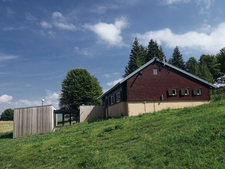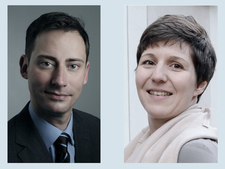-
Topics
subnavigation
Topics
Electromagnetic fields
- What are electromagnetic fields?
- Static and low-frequency fields
- Radiation protection relating to the expansion of the national grid
- High-frequency fields
- Radiation protection in mobile communication
Optical radiation
Ionising radiation
- What is ionising radiation?
- Radioactivity in the environment
- Applications in medicine
- Applications in daily life and in technology
- Effects
- What are the effects of radiation?
- Effects of selected radioactive materials
- Consequences of a radiation accident
- Cancer and leukaemia
- Genetic radiation effects
- Individual radiosensitivity
- Epidemiology of radiation-induced diseases
- Ionising radiation: positive effects?
- Risk estimation and assessment
- Radiation protection
- Nuclear accident management
- Service offers
-
The BfS
subnavigation
The BfS
- About us
- Science and research
- Laws and regulations
- BfS Topics in the Bundestag
- Links
Low concentrations of ruthenium-106 detected in Europa
- Slightly elevated levels of radioactivity in the atmosphere have been detected at several trace monitoring stations in Europe since 29.09.2017.
- Trace monitoring stations of Germany's National Meteorological Service (Deutscher Wetterdienst, DWD) have recorded low levels of ruthenium-106 at 7 stations in Germany.
- Readings in Germany range from a few microbecquerel to 5 millibecquerel per cubic metre air.
- These low levels of radioactivity do not pose a health hazard to the population.
- Analyses as to the origin of the radioactive substance ruthenium-106 suggest a high probability of a radioactive release in the Southern Ural, although other areas in the South of Russia cannot be ruled out.

![]() The Schauinsland monitoring station of the BfS with the new annexe for the RASA air sampler
The Schauinsland monitoring station of the BfS with the new annexe for the RASA air sampler
Slightly elevated levels of radioactivity in the atmosphere have been detected at several trace monitoring station in Europe since 29.09.2017. Low levels of ruthenium-106 (Ru-106) were detected at six stations in Germany and several European stations, among others in Austria, Switzerland and Italy.
The concentration of the radioactive substance is very low ranging from a few microbecquerel to a few millibecquerel per cubic metre. These low levels of radioactivity do not pose a health hazard to the population.
Accident at a nuclear power plant ruled out as a cause
An accident at a nuclear power plant can be ruled out as a possible cause, since solely ruthenium-106 has been detected. Ruthenium-106 (Ru-106) is used as a radiation source in cancer therapy for the treatment of ocular tumours. Ruthenium can also occur during the reprocessing of nuclear fuel elements. In addition, ruthenium-106 is used in radioisotope thermoelectric generators (RTG), which serve for the power supply of satellites. Discussions with the French Institut de Radioprotection et de Sûreté Nucléaire (IRSN) about possible sources of the release show that they reach similar conclusions.
The origin of the ruthenium-106 readings is still unclear. Backward calculations of the atmospheric dispersion of radioactive material allow to delimit the areas where the release might have occurred. Recent analyses as to the source of the radioactive substance suggest a high probability of a radioactive release in the Southern Ural, although other areas in the South of Russia still cannot be ruled out. According to the backward calculations the release occurred during the last week of September.
BfS is continuously evaluating all available readings of radioactive substances in the atmosphere, among others from the monitoring station on the Schauinsland mountain.
Trace surveys in Germany
Slightly elevated levels of ruthenium-106 were first reported from Austria on 03.10.2017. A trace monitoring station in Germany also recorded low amounts of ruthenium-106 on 04.10.2017: a monitoring station of Germany's National Meteorological Service (Deutscher Wetterdienst, DWD) in Görlitz (Saxony) detected traces of the radioactive substance when analysing a sample collected between 25.09.2017 and 02.10.2017.
The concentration of ruthenium-106 measured by DWD in Görlitz was about five millibecquerels per cubic metre air. Constant inhalation of this of this activity concentration over one week's time (i.e. the period over which the air was collected by the DWD) would result in a dose below 100 nanosieverts (1 nanosievert = 10-9 Sievert). This dose is below that from natural background radiation within one hour. Measures to protect the population would be taken at a dose of 10 millisieverts (1 millisievert = 10-3 Sievert); the ruthenium-106 dose in Görlitz is 100,000 times smaller.
Subsequently, DWD detected traces of ruthenium-106 in the atmosphere at five other stations (Arkona/Rügen, Greifswald, Angermünde, Cottbus, and Fürstenzell/Bavaria); theses samples were also collected over the period from 25.09.2017 to 02.10.2017. The readings, ranging from a few microbecquerels to one millibecquerel per cubic metre air, are somewhat lower than those at the Görlitz station. In addition, DWD continued to collect samples from 02.10.2017 to 04.10.2017 and identified traces of ruthenium-106 at the Görlitz station.
Between 02.10.2017 and 09.10.2017, the DWD detected Ruthenium-106 at five stations (Görlitz, Angermünde, Cottbus, Fürstenzell/Bavaria, and Seehausen). In Görlitz, they were in the range of a few millibecquerel per cubic meter of air (between 02.10.2017 and 04.10.2017), at the other stations in the range of a few 10 microbequerel per cubic meter. Between 04.10.2017 and 09.10.2017 no ruthenium-106 could be detected in Görlitz.
Monitoring results
The table contains monitoring results for Ruthenium-106 in air in Germany for those monitoring stations of Germany's National Meteorological Service DWD, where traces of Ruthenium-106 have been detected. Longitude and latitude is given for the monitoring stations to allow further scientific use of the data, e.g. for comparison with results of atmospheric dispersion calculations.
| Station | Activityconcentration | Longitude | Latitude |
|---|---|---|---|
| collected during 25.09.2017 to 02.10.2017- | |||
| Arkona | 0,01 | 13.43355 | 54.67812 |
| Görlitz | 4,9 | 14.95027 | 51.16234 |
| Greifswald | 0,01 | 13.40509 | 54.09619 |
| Cottbus | 0,67 | 14.31669 | 51.77614 |
| Fürstenzell | 0,02 | 13.35245 | 48.54421 |
| Angermünde | 0,16 | 13.99079 | 53.03145 |
| collected during 02.10.2017 to 04.10.2017- | |||
| Görlitz | 4,6 | 14.95027 | 51.16234 |
| collected during 02.10.2017 to 09.10.2017- | |||
| Cottbus | 0,17 | 14.31669 | 51.77614 |
| Fürstenzell | 0,20 | 13.35245 | 48.54421 |
| Angermünde | 0,05 | 13.99079 | 53.03145 |
| Seehausen | 0,01 | 11.72996 | 52.89113 |
State of 2017.10.11



